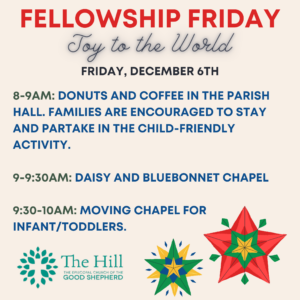Hillside will be closed for Martin Luther King Jr. Day.
The Hillside Blog
First Friday
Join us for coffee, donuts, and fellowship in the Parish Hall.

Winter Break
Hillside will be closed for Winter Break.
Coats for Kids Drive Ends
Today is the last day to bring a new or gently used coat to Hillside for the Coats for Kids drive.
Coats for Kids Drive Begins
As we anticipate cold weather this winter, we are excited to share an opportunity to ensure Central Texas children can stay warm. Join us in supporting Hillside’s efforts in keeping the children of Central Texas warm with a Coats for Kids donation drive of new or gently used winter coats.
Hillside will be collecting coats until December 2nd, and the goal is 100 coats! Please drop off coats at the main office.
Thanksgiving Break
Hillside will be closed for Thanksgiving Break.
Hillside Closed for Professional Development.
Hillside will be closed to children for Staff Professional Development.
Art Gallery & Winter Market – Sunday Event
Join us for an afternoon of art. Each child at Hillside will have their work displayed, and there will also be items to take home.